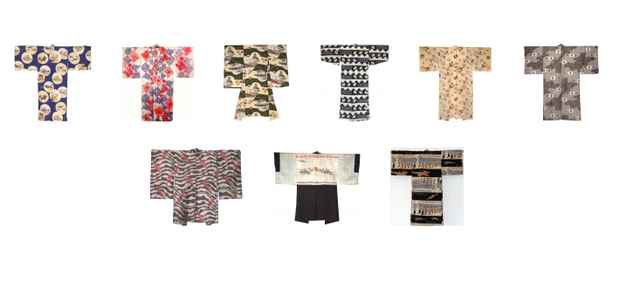“Japanese Propaganda Kimonos 1905-1941” Exhibition
Edward Thorp Gallery

This event has ended.
Edward Thorp Gallery presents the first New York gallery exhibition of primarily pre-World War II Japanese Propaganda Kimonos . On display will be approximately 30 pieces showcasing the inventiveness and diversity of these garments . Printed, dyed, and embroidered wovens of silk, wool, cotton, and rayon, these kimono ( meaning ‘something to wear’) , nagajuban (under - robes), and haori (short jackets), are a remarkable graphic record of an extraordinarily complex and turbulent time. The tradition of pictures on kimonos is not a modern invention, but with the Sino-Japanese and Russo - Japanese Wars in 1895 and 1905, it took a marked turn. Images of troops, cannon, and battleships were soon commonplace , reflecting the country’s perceived prestige and strength. The Japanese annexation of Manchuria in 1931 furthered these textile depictions of conflict. Manchukuo , the colonial rebranding of Manchuria, was a potent leitmotif in many kimonos. Traditional motifs and folk tales appear in dynamic interplay with the militarist ethos of the prints , many of which bear the unmistakable stylistic influence of Art Deco. While battles, banzai charges , and kamikaze are prominent, the military ships and planes interspersed with maps, newspapers, jazzy cartouches, children, and pets were especially cherished as measures of futurity and sophistication. The first streamlined t rain in Asia, built in Japan, appears on one kimono , along with other technological advances like Nippon Go , the first Japanese planes to set world air speed records. Modernity took many forms in 1930s Japan , and in the years before militarism pushed the country towards war , it was most visibly associated with consumer culture. Inundated with jazz age trends and new technologies, kimonos were a key source in visualizing what it meant to be modern in Japan. These rare and unfamiliar graphics reflect a unique melding of history, cultural import, and beauty. Astonishing not only for their visual impact , the kimonos provide an unmatched insight int o a rapidly transforming nation.
Media
Schedule
from September 10, 2015 to October 17, 2015